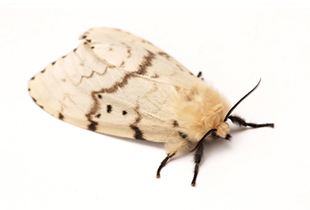

SPECIES: S Lymantria dispar (order Lepidoptera)
COMMON NAME: Defoliating Lepidoptera, better known as the “gypsy moth”.
SIZE: Adult males have a wingspan of 35-40 mm, while that of females is 40-70 mm. Mature larvae reach a length of 60-70 mm.
LIFECYCLE: The species has only one generation per year and overwinters as larvae within the egg. In the spring (April-May), the newly hatched larvae leave the corium with a marked tendency to spread in the environment. The adults appear en mass between late June and throughout July, but can continue to emerge during the month of August and early September. This is followed by the deposition of eggs in egg sacs protected by the abdominal hair of the female, which isolates each egg from the others. The numerical structure of the egg sacs and its location on the plants provides an acceptable indication of the insect's status within the population. Indeed, egg masses with 600-800 units laid up to a height of 2 m on the trunk indicate that the insect is in a phase of latency or progradation; a reduction in the number of eggs to around 300-500, and their location up to six metres in height and on the first branches indicates peak status and retrograde gradation. However, during periods of maximum intensity of infestation, any location is valid for egg-laying.
HABITAT: Polyphagous, it is found on plants of the following genera: Acer, Fagus, Alnus, Ulmus, Tilia, Platanus, Quercus and Prunus.
FEATURES: Adults: males yellowish brown with black transverse stripes on the front wings, with a slim abdomen. Females are more stout-looking, off-white, and have front wings with some zigzag streaks that travel from front to rear, and a V-position distal-median line, that is always present, unlike other markings. Larvae: on maturity, they look very distinctive due to the particular coloration of dorsal tubercles that are part of the six on each segment. In fact the first five pairs of blue contrasts with the red of the other. All this on a brown/yellowish-gray body abundantly covered with bristles that differ at the aforementioned tubercles. They have a structure that, equipped with aerophilous hairs, can use the wind to passively reach plants a few kilometers away from the point of hatching.
DIET/DAMAGE: The larvae eat during the day during the early stages, and by night in the next. Maturity is reached in June-July and the crhrysalis stage is almost always on the plants where the insect grew. Infestations of Lymantria in Italy is classified as "temporary" because the latency period interspersed with two gradation is variable. Harmfulness period - from May to June.
I want to sterminate itNeed to disinfest your plants? Gallura Disinfestazioni has the solution against parasites. Contact us for a free consultation and quote!